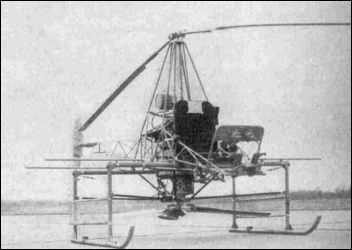Bruno Nagler, whose earliest rotary wing experiments go back to 1929, emigrated to the United States in 1952.
There he has built various prototypes, all single-seaters like his former designs, but with a totally different concept of an anti-torque rotor in the extension of the main rotor.
XNH I HELIGLIDER (1952)
This, the first rotorcraft which Nagler designed after his arrival in the United States, was of the 'strap-on' variety.
Its intended use was to cross rivers or other obstacles. The required height was to be reached by power from six solid-propellent rockets, fired in pairs and providing a 9kg thrust for about twenty seconds. Slow descent was ensured by the auto-rotation of the rotor. The six rockets could be replaced for later use.
The wearer's legs were to be the landing gear.
CONVERTOCRAPT 130 (1954)
This convertiplane consisted of an Aeronca fuselage minus the wings and plus a two-bladed rotor powered by six solid fuel rockets placed three at the tip of each blade and each providing a 41-68kg thrust. The airscrew used for forward flight was powered by a Continental reciprocating engine. After the rocket power take-off, the Convertocraft flies forward with the rotor freewheeling. Engine: Continental, and 6 rockets Rotor diameter: 30 ft (9-14 m) Weight fully loaded: 1.450 Ib (657-7 kg) Cruising speed: 80 m.p.h. (128 k.p.h.) Number of seats: 2
NH-120 (1954)
This ultra-light single-seater has two rotors: one main rotor with collective and cyclic pitch control, the latter by a hanging stick, and one smaller anti-torque rotor. Nagler's ingenuity in this design consists in placing the latter above the main rotor, which is thus surmounted by the driving engine directly above it and a two-bladed, much smaller diameter fixed-pitch rotor. This compact unit, two rotors with the engine between them, is supported by the helicopter frame made of tubes and containing the pilot's seat with fuel tanks behind it. The 45hp engine originally planned for proved insufficiently powerful and has been replaced. The tricycle landing gear has three wheels held at the end of legs fitted with shock absorbers.
When folded this rotorcraft will go into a container measuring 0.77 by 2.13m.
NH 160 (1956)
This later version incorporates the lessons learnt from the NH 120, and while the general principle remains the same, i.e. the main rotor in the same alignment as the anti-torque rotor, their positions have been changed.
The two-bladed main rotor remains in its usual position, but the anti-torque rotor with three articulated blades is on the helicopter's underside between the two skis acting as landing gear, and 1.83m away from the main rotor. The latter has cyclic and collective control and is mounted on an oscillating hub. In horizontal flight it turns at 400 r.p.m. and the lower rotor at 1.500 r.p.m., the latter consuming 55hp, the former 15hp of the engine's total power.
Nagler has designed an unusual steering system: two disc brakes of the kind used in motor vehicles, one acting on the main rotor, the other on the shaft of the engine to which the anti-torque rotor is fixed. These brakes are pedal operated.
A fixed vertical surface at the end of the rudimentary fuselage ensures directional stability. The production model is planned to have an enclosed cockpit and fuselage.
P.Lambermont "Helicopters and Autogyros of the World", 1958





